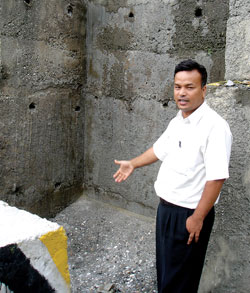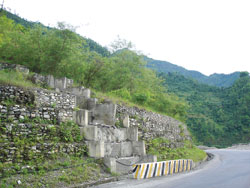|
|
| FIGHTING GRAVITY WITH BIOLOGY: While the vegetation holds the topsoil together, water and debris at Krishna Bhir are managed by check dams, sloping drains and culverts (above). "The great thing about plantsis that they make the slope stronger as they get older," says Naresh man Shakya (below). |
Krishna Bhir. For the past decade, this infamous landslide on the Prithbi Highway has become synonymous with road closure. Every monsoon, the massive slide 83km west of Kathmandu would block the road for weeks on end, cutting the capital off from the rest of the country.
This year, despite heavier than usual monsoon rains Krishna Bhir is not in the news. The reason is that a Nepali road engineer has used biology to fight gravity.
Naresh Man Shakya is a geo-technical engineer at the Department of Roads (DoR) who worked for four years to stabilise the slopes above the highway by planting special grass, shrubs and trees, building check dams, and constructing proper drainage.
This is nothing new. Shakya and his colleagues just borrowed from Nepali farmers who have protected their terrace farms by planting special shrubs. Combined with modern engineering structures, this has been a cheap and effective way to
control landslides on Krishna Bhir and along other highways.
Nepal's fragile geology and heavy rainfall makes it expensive to build and maintain roads. Usually, costly civil works are needed to protect a highway from slides. Bio-engineering offers a cheap alternative. The technique has been used on the Dhangadi-Dadeldhura and Lamosangu-Jiri highways, but it was on the Dharan-Dhankuta road that it was employed most extensively since it passes through terrain with very high rainfall.
What is remarkable about Krishna Bhir is that Shakya and his team successfully solved a problem for only Rs 38 million, a fraction of the cost being proposed by a Japanese aid group. Shakya, who turned down offers to work abroad, has now been called upon to apply his geotechnical skills on roads in Bhutan and Laos.
 "If the right person is placed in a right place for a challenging job and given enough authority and support, anything can be achieved," Shakya says modestly. But that is exactly what is not happening after Shakya's success along the Prithbi Highway. He has been transferred to a desk job in Kathmandu instead of challenging jobs in new strategic highway projects.
"If the right person is placed in a right place for a challenging job and given enough authority and support, anything can be achieved," Shakya says modestly. But that is exactly what is not happening after Shakya's success along the Prithbi Highway. He has been transferred to a desk job in Kathmandu instead of challenging jobs in new strategic highway projects.
There are many road engineers in Nepal who have the zeal and commitment and can be trusted for any work that foreign consultants are doing here for huge amounts of money. But they are underutilised, that is what makes Shakya a bit unhappy.
Today, as bus passengers whiz along the Prithbi Highway from Kathmandu to Mugling, they don't even realise they've crossed this notorious 200m stretch of highway that used to be one huge gash above the Trisuli River. In fact, the highway is now wider than normal at this point. Looking up the slope at what used to be a moonscape, where a whole mountain side had slid down to the river, there is now a lush green forest.
And it's not just Krishna Bhir, the technology has been applied to stabilise the 100 or so major landslides triggered by heavy monsoons in 2001 on the Prithbi and Mugling-Narayanghat highways. The Department of Roads (DoR) has now made the bio-engineering of roadside slopes a part of its standard operating procedure on new roads and maintenance of existing ones.
Shakya has found the best combination to strengthen slopes: grasses act to hold the soil together with their roots, while dense shrubs work as a catch wall. Bamboos retain the slope and broad-leaf plants like bhujetro, which can even grow in harsh conditions and reduce damage from direct rainfall.
Prakash Bhakta Upadhyaya, an engineer at Bharatpur Division Office of DoR, says slope degradation is considerably lessened along highways where bio-engineering is applied. He says: "It extends the lifespan of roads and reduces the maintenance cost."



